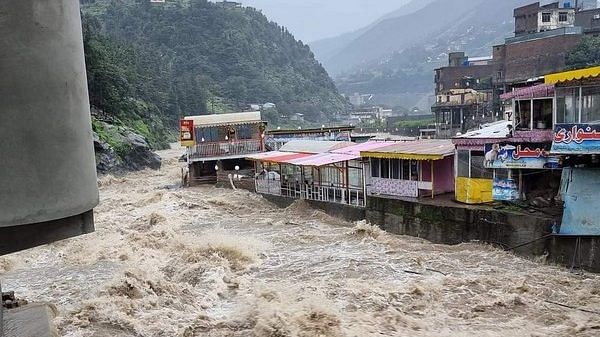New Delhi: Pakistanis are bracing themselves for a surge in the cost of milk, eggs and meat. With a third of the country under water, the nation is staring at a food and livestock crisis. Authorities are still taking stock of the toll the floods have wrought on fish farms and cattle.
While some reports estimate that over 7 lakh heads of cattle have been killed since mid-June, others say the toll could be as high as 26 lakh. This will only add to the food crisis affecting millions of people in 57 districts that have been flooded. Pakistan’s Cattle & Dairy Farmers Association has already brought this to the attention of Prime Minister Shahbaz Sharif, ThePrint reported Sunday.
Agriculture contributes around 23 per cent of Pakistan’s GDP. Some estimates indicate that 21 million acres (78,000 km2) of crops across the nation have been swamped by the floods and environmental catastrophe. Causing damages worse than the 2004 earthquakes, Pakistan is seeing the highest rainfall in at least 40 years.
Around 1,200 people have already been reported dead, further affecting the situation of Pakistan’s labour force in agriculture, which makes up 40 per cent of employment opportunities.
Also read: Jemima Goldsmith comes to Pakistan’s aid again—to raise funds via pvt screening of her film
Pakistanis’ reliance
Nearly 40 per cent of income for eight million rural households in Pakistan comes from raising cattle. And the livestock sector makes up for 61 per cent of Pakistan’s value-added products. The share of livestock in the country’s GDP stands at 14 per cent.
Those which escaped the fatality of the floods are still prone to foot and mouth and other stomach diseases that are being spread by the floods, leading to a meat shortage.
Progressive Farmer Aamir Hayat Bhandara told The Express Tribune that the economic condition of rural families who depended on livestock for income, has deteriorated. Furthermore, the country’s economy is also being affected as there is already a shortage of meat, milk, curd and other milk products.
Exacerbating the situation, a lumpy skin disease (LSD) outbreak in cattle has further contributed to soaring meat prices across the country. Khyber Pakhtunkhwa being the hardest hit, seeing over 46,000 cases.
As of 31 August, livestock deaths in Pakistan’s Punjab stand at 2,05,104. In Sindh, casualties have soared over 18,000. In Khyber Pakhtunkhwa, according to official figures, over 9,000 cattle heads have been lost in the floods, taking the total tally of agricultural and livestock losses in the province to Rs1.89 billion.
The highest number of livestock, with 84,783, was reported in Kashmore following the perishing of 8000 livestock in Khairpur.4-1/12
— Zahid Gishkori (@ZahidGishkori) September 4, 2022
The crisis has also made villagers circumspect about leaving their cattle behind, despite not being able to feed them. Villagers in the Sindh province continue to scramble for food not just for themselves, but for their animals as well.
“We have buffaloes, cows and goats… if we leave the cattle behind they would be stolen,” said Shah Mohammad from the Sindh province, to Samaa TV.
Also read: Luxury ‘Bentley Mulsanne’ car stolen from London recovered in Karachi
Impact on new cropping season
It will take at least 2-3 months for the water to completely recede from the flooded areas and this may still be a bridge too far for the planting of the winter staple crop — wheat.
As reported by ThePrint, citing AFP, farmers in provinces like Sindh need to begin planting the winter wheat crop by October.
Being the fifth largest cotton producer and accounting for five per cent of global output, as much as half of Pakistan’s cotton crop has been destroyed, Planning Minister Ahsan Iqbal said last week.
Such a state of affairs might obligate the government to additionally import cotton worth $2.6 billion, and reduce the country’s textile production owing to unavailability of raw materials, causing a $1 billion loss of exports.
Also read: A menstrual campaign amid Pakistan floods is making right noises. But some men can’t take it
Political hurdles and foreign aid
As Pakistanis mobilise on social media and on the ground to raise funds, awareness and extend help, the Sindh Police have been criticised for allegedly creating hurdles and accepting bribes.
The allegations were made by Anas Abdullah of Islamabad-based think tank Centre for Strategic and Contemporary Research, who cited his brother’s experience of conducting aid work in flood-affected parts of Sindh.
My brother came back after spending 7 days in flood affected areas of Sindh. Sharing his few first hand experiences for public consumption.
1. Sindh Police is creating hurdles for trucks and vehicles loaded with relief goods. At many places they allow only after taking bribe 1/n
— Anas انس (@_AnasAbdullah) September 4, 2022
Abdullah further leveled accusations of favouritism towards more privileged farmers, blaming Sindh’s “political elite” of working hand-in-glove with the police to interfere in relief efforts.
Sindh police has yet to publicly respond to the claims of bribery.
Amid soaring prices, the government has begun importing vegetables from Iran and Afghanistan. Pakistan is also in touch with Russia, to procure wheat after the floods destroyed grains that many villages had been saving up in their homes. Pakistan’s finance minister Miftah Ismail had recently stated that they were also considering importing food items from India.
The relief work too is being impacted. From the Sindh province, Ghulam Kubra, 32, mother of four tells The Guardian, “The stagnant water is knee-deep and it is difficult for relief workers to reach us.”
With nothing to eat and not enough resources in sight, Ghulam adds, “I’m not complaining, only stating the fact as everyone is in the same boat. Today the richer among us have become paupers too.”
With inputs from Raghav Bikhchandani.



